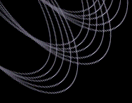
| Home |
| Where to Start |
| News and Updates |
| Tutorials |
| Data Products |
| Data Access |
| Sky Coverage |
| Instruments |
| Data Flow |
| Algorithms |
| Glossary |
| Known Problems |
| Help and Feedback |
| Search |
 |
Deblending Overlapping ObjectsOne of the jobs of the frames pipeline is to decide if an initial single detection is in fact a blend of multiple overlapping objects, and, if so, to separate, or deblend them. The deblending process is performed self-consistently across the bands (thus, all children have measurements in all bands). After deblending, the pipeline again measures the properties of these individual children. Bright objects are measured at least twice: once with a global sky
and no deblending run (this detection is flagged
Once objects are detected, they are deblended by identifying
individual peaks within each object, merging the list of peaks across
bands, and adaptively determining the profile of images associated
with each peak, which sum to form the original image in each band. The
originally detected object is referred to as the "parent" object and
has the flag
The list of peaks in the parent is trimmed to combine peaks (from
different bands) that are too close to each other (if this happens,
the flag
In a number of situations, the deblender decides not to process a
On average, about 15% - 20% of all detected objects are blended,
and many of these are superpositions of galaxies that the deblender
successfully treats by separating the images of the nearby
objects. Thus, it is almost always the childless
( The behavior of the deblender of overlapping images has been further improved since the DR1; these changes are most important for bright galaxies of large angular extent (> 1 arcmin). In the EDR, and to a lesser extent in the DR1, bright galaxies were occasionally ``shredded'' by the deblender, i.e., interpreted as two or more objects and taken apart. With improvements in the code that finds the center of large galaxies in the presence of superposed stars, and the deblending of stars superposed on galaxies, this shredding now rarely happens. Indeed, inspections of several hundred NGC galaxies shows that the deblend is correct in 95% of the cases; most of the exceptions are irregular galaxies of various sorts. Last modified: Fri Oct 1 13:41:45 CDT 2004 |